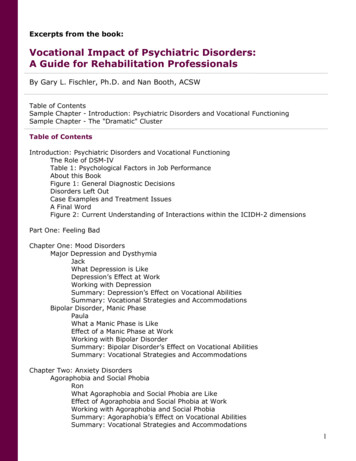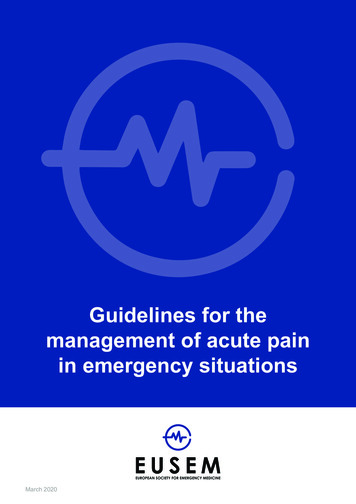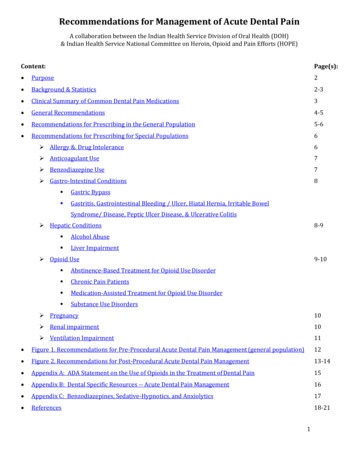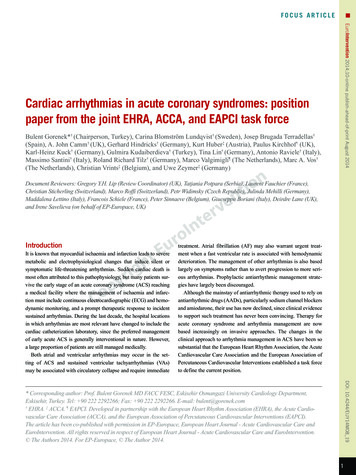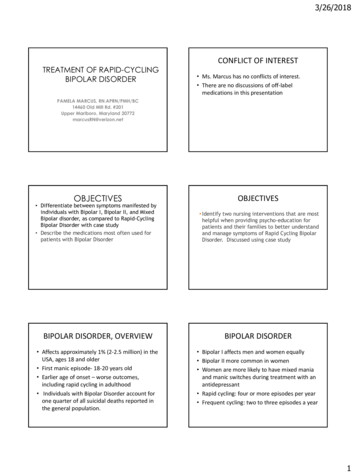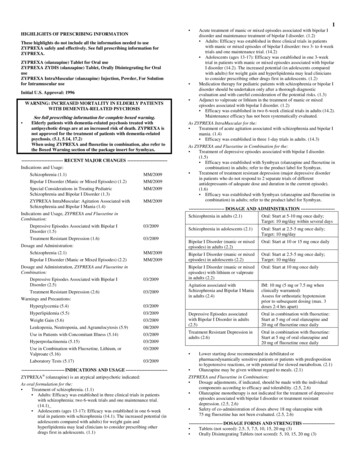
Transcription
1 HIGHLIGHTS OF PRESCRIBING INFORMATIONThese highlights do not include all the information needed to useZYPREXA safely and effectively. See full prescribing information forZYPREXA.ZYPREXA (olanzapine) Tablet for Oral useZYPREXA ZYDIS (olanzapine) Tablet, Orally Disintegrating for OraluseZYPREXA IntraMuscular (olanzapine) Injection, Powder, For Solutionfor Intramuscular use Initial U.S. Approval: 1996WARNING: INCREASED MORTALITY IN ELDERLY PATIENTSWITH DEMENTIA-RELATED PSYCHOSIS See full prescribing information for complete boxed warning. Elderly patients with dementia-related psychosis treated withantipsychotic drugs are at an increased risk of death. ZYPREXA isnot approved for the treatment of patients with dementia-relatedpsychosis. (5.1, 5.14, 17.2)When using ZYPREXA and fluoxetine in combination, also refer tothe Boxed Warning section of the package insert for Symbyax.--------------------------- RECENT MAJOR CHANGES ------------------------- Indications and Usage:Schizophrenia (1.1)MM/2009Bipolar I Disorder (Manic or Mixed Episodes) (1.2)MM/2009Special Considerations in Treating PediatricSchizophrenia and Bipolar I Disorder (1.3)MM/2009ZYPREXA IntraMuscular: Agitation Associated withSchizophrenia and Bipolar I Mania (1.4)MM/2009Acute treatment of manic or mixed episodes associated with bipolar Idisorder and maintenance treatment of bipolar I disorder. (1.2) Adults: Efficacy was established in three clinical trials in patientswith manic or mixed episodes of bipolar I disorder: two 3- to 4-weektrials and one maintenance trial. (14.2) Adolescents (ages 13-17): Efficacy was established in one 3-weektrial in patients with manic or mixed episodes associated with bipolarI disorder (14.2). The increased potential (in adolescents comparedwith adults) for weight gain and hyperlipidemia may lead cliniciansto consider prescribing other drugs first in adolescents. (1.2)Medication therapy for pediatric patients with schizophrenia or bipolar Idisorder should be undertaken only after a thorough diagnosticevaluation and with careful consideration of the potential risks. (1.3)Adjunct to valproate or lithium in the treatment of manic or mixedepisodes associated with bipolar I disorder. (1.2) Efficacy was established in two 6-week clinical trials in adults (14.2).Maintenance efficacy has not been systematically evaluated.As ZYPREXA IntraMuscular for the: Treatment of acute agitation associated with schizophrenia and bipolar Imania. (1.4) Efficacy was established in three 1-day trials in adults. (14.3)As ZYPREXA and Fluoxetine in Combination for the: Treatment of depressive episodes associated with bipolar I disorder.(1.5) Efficacy was established with Symbyax (olanzapine and fluoxetine incombination) in adults; refer to the product label for Symbyax. Treatment of treatment resistant depression (major depressive disorderin patients who do not respond to 2 separate trials of differentantidepressants of adequate dose and duration in the current episode).(1.6) Efficacy was established with Symbyax (olanzapine and fluoxetine incombination) in adults; refer to the product label for Symbyax.----------------------- DOSAGE AND ADMINISTRATION --------------------- Indications and Usage, ZYPREXA and Fluoxetine inCombination:Depressive Episodes Associated with Bipolar IDisorder (1.5)03/2009Treatment Resistant Depression (1.6)03/2009Dosage and Administration:Schizophrenia in adults (2.1)Oral: Start at 5-10 mg once daily;Target: 10 mg/day within several daysSchizophrenia in adolescents (2.1)Oral: Start at 2.5-5 mg once daily;Target: 10 mg/dayBipolar I Disorder (manic or mixedepisodes) in adults (2.2)Oral: Start at 10 or 15 mg once dailySchizophrenia (2.1)MM/2009Bipolar I Disorder (Manic or Mixed Episodes) (2.2)MM/2009Bipolar I Disorder (manic or mixedepisodes) in adolescents (2.2)Oral: Start at 2.5-5 mg once daily;Target: 10 mg/dayOral: Start at 10 mg once dailyDepressive Episodes Associated with Bipolar IDisorder (2.5)03/2009Bipolar I Disorder (manic or mixedepisodes) with lithium or valproatein adults (2.2)Treatment Resistant Depression (2.6)03/2009Agitation associated withSchizophrenia and Bipolar I Maniain adults (2.4)IM: 10 mg (5 mg or 7.5 mg whenclinically warranted)Assess for orthostatic hypotensionprior to subsequent dosing (max. 3doses 2-4 hrs apart)Depressive Episodes associatedwith Bipolar I Disorder in adults(2.5)Oral in combination with fluoxetine:Start at 5 mg of oral olanzapine and20 mg of fluoxetine once dailyTreatment Resistant Depression inadults (2.6)Oral in combination with fluoxetine:Start at 5 mg of oral olanzapine and20 mg of fluoxetine once dailyDosage and Administration, ZYPREXA and Fluoxetine inCombination:Warnings and Precautions:Hyperglycemia (5.4)03/2009Hyperlipidemia (5.5)03/2009Weight Gain (5.6)03/2009Leukopenia, Neutropenia, and Agranulocytosis (5.9)08/2009Use in Patients with Concomitant Illness (5.14)03/2009Hyperprolactinemia (5.15)03/2009Use in Combination with Fluoxetine, Lithium, orValproate (5.16)03/2009Laboratory Tests (5.17)03/2009 Lower starting dose recommended in debilitated orpharmacodynamically sensitive patients or patients with predispositionto hypotensive reactions, or with potential for slowed metabolism. (2.1)Olanzapine may be given without regard to meals. (2.1)---------------------------- INDICATIONS AND USAGE -------------------------- ZYPREXA (olanzapine) is an atypical antipsychotic indicated:ZYPREXA and Fluoxetine in Combination: Dosage adjustments, if indicated, should be made with the individualcomponents according to efficacy and tolerability. (2.5, 2.6) Olanzapine monotherapy is not indicated for the treatment of depressiveepisodes associated with bipolar I disorder or treatment resistantdepression. (2.5, 2.6) Safety of co-administration of doses above 18 mg olanzapine with75 mg fluoxetine has not been evaluated. (2.5, 2.6)As oral formulation for the: Treatment of schizophrenia. (1.1) Adults: Efficacy was established in three clinical trials in patientswith schizophrenia: two 6-week trials and one maintenance trial.(14.1) Adolescents (ages 13-17): Efficacy was established in one 6-weektrial in patients with schizophrenia (14.1). The increased potential (inadolescents compared with adults) for weight gain andhyperlipidemia may lead clinicians to consider prescribing otherdrugs first in adolescents. (1.1)---------------------- DOSAGE FORMS AND STRENGTHS -------------------- Tablets (not scored): 2.5, 5, 7.5, 10, 15, 20 mg (3) Orally Disintegrating Tablets (not scored): 5, 10, 15, 20 mg (3)
2 Intramuscular Injection: 10 mg vial S----------------------------- None with ZYPREXA monotherapy. When using ZYPREXA and fluoxetine in combination, also refer to theContraindications section of the package insert for Symbyax . (4) When using ZYPREXA in combination with lithium or valproate, referto the Contraindications section of the package inserts for thoseproducts. (4)------------------------ WARNINGS AND PRECAUTIONS ---------------------- Elderly Patients with Dementia-Related Psychosis: Increased risk ofdeath and increased incidence of cerebrovascular adverse events (e.g.,stroke, transient ischemic attack). (5.1) Suicide: The possibility of a suicide attempt is inherent in schizophreniaand in bipolar I disorder, and close supervision of high-risk patientsshould accompany drug therapy; when using in combination withfluoxetine, also refer to the Boxed Warning and Warnings andPrecautions sections of the package insert for Symbyax. (5.2) Neuroleptic Malignant Syndrome: Manage with immediatediscontinuation and close monitoring. (5.3) Hyperglycemia: In some cases extreme and associated with ketoacidosisor hyperosmolar coma or death, has been reported in patients takingolanzapine. Patients taking olanzapine should be monitored forsymptoms of hyperglycemia and undergo fasting blood glucose testingat the beginning of, and periodically during, treatment. (5.4) Hyperlipidemia: Undesirable alterations in lipids have been observed.Appropriate clinical monitoring is recommended, including fastingblood lipid testing at the beginning of, and periodically during,treatment. (5.5) Weight Gain: Potential consequences of weight gain should beconsidered. Patients should receive regular monitoring of weight. (5.6) Tardive Dyskinesia: Discontinue if clinically appropriate. (5.7) Orthostatic Hypotension: Orthostatic hypotension associated withdizziness, tachycardia, bradycardia and, in some patients, syncope, mayoccur especially during initial dose titration. Use caution in patients withcardiovascular disease, cerebrovascular disease, and those conditionsthat could affect hemodynamic responses. (5.8) Leukopenia, Neutropenia, and Agranulocytosis: Has been reported withantipsychotics, including ZYPREXA. Patients with a history of aclinically significant low white blood cell count (WBC) or drug inducedleukopenia/neutropenia should have their complete blood count (CBC)monitored frequently during the first few months of therapy anddiscontinuation of ZYPREXA should be considered at the first sign of aclinically significant decline in WBC in the absence of other causativefactors. (5.9) Seizures: Use cautiously in patients with a history of seizures or withconditions that potentially lower the seizure threshold. (5.11) Potential for Cognitive and Motor Impairment: Has potential to impairjudgment, thinking, and motor skills. Use caution when operatingmachinery. (5.12) Hyperprolactinemia: May elevate prolactin levels. (5.15) Use in Combination with Fluoxetine, Lithium or Valproate: Also refer tothe package inserts for Symbyax, lithium, or valproate. (5.16) Laboratory Tests: Monitor fasting blood glucose and lipid profiles at thebeginning of, and periodically during, treatment. (5.17)Most common adverse reactions ( 5% and at least twice that for placebo)associated with:Oral Olanzapine Monotherapy: Schizophrenia (Adults) – postural hypotension, constipation, weightgain, dizziness, personality disorder, akathisia (6.1) Schizophrenia (Adolescents) – sedation, weight increased, headache,increased appetite, dizziness, abdominal pain, pain in extremity, fatigue,dry mouth (6.1) Manic or Mixed Episodes, Bipolar I Disorder (Adults) – asthenia, drymouth, constipation, increased appetite, somnolence, dizziness, tremor(6.1) Manic or Mixed Episodes, Bipolar I Disorder (Adolescents) – sedation,weight increased, increased appetite, headache, fatigue, dizziness, drymouth, abdominal pain, pain in extremity (6.1)Combination of ZYPREXA and Lithium or Valproate: Manic or Mixed Episodes, Bipolar I Disorder (Adults) – dry mouth,weight gain, increased appetite, dizziness, back pain, constipation,speech disorder, increased salivation, amnesia, paresthesia (6.1)ZYPREXA and Fluoxetine in Combination: Also refer to the AdverseReactions section of the package insert for Symbyax. (6)ZYPREXA IntraMuscular for Injection: Agitation with Schizophrenia and Bipolar I Mania (Adults) –somnolence (6.1)To report SUSPECTED ADVERSE REACTIONS, contact Eli Lilly andCompany at 1-800-LillyRx (1-800-545-5979) or FDA at 1-800-FDA-1088or - DRUG INTERACTIONS ----------------------------- Diazepam: May potentiate orthostatic hypotension. (7.1, 7.2) Alcohol: May potentiate orthostatic hypotension. (7.1) Carbamazepine: Increased clearance of olanzapine. (7.1) Fluvoxamine: May increase olanzapine levels. (7.1) ZYPREXA and Fluoxetine in Combination: Also refer to the DrugInteractions section of the package insert for Symbyax. (7.1) CNS Acting Drugs: Caution should be used when taken in combinationwith other centrally acting drugs and alcohol. (7.2) Antihypertensive Agents: Enhanced antihypertensive effect. (7.2) Levodopa and Dopamine Agonists: May antagonize levodopa/dopamineagonists. (7.2) Lorazepam (IM): Increased somnolence with IM olanzapine. (7.2) Other Concomitant Drug Therapy: When using olanzapine incombination with lithium or valproate, refer to the Drug Interactionssections of the package insert for those products. (7.2)------------------------USE IN SPECIFIC POPULATIONS---------------------- Pregnancy: ZYPREXA should be used during pregnancy only if thepotential benefit justifies the potential risk to the fetus. (8.1) Nursing Mothers: Breast-feeding is not recommended. (8.3) Pediatric Use: Safety and effectiveness of ZYPREXA in children 13years of age have not been established. (8.4)See 17 for PATIENT COUNSELING INFORMATION and FDAapproved Medication GuideRevised: MM/2009-------------------------------ADVERSE REACTIONS ----------------------------- 2.22.3FULL PRESCRIBING INFORMATION: CONTENTS*WARNING: INCREASED MORTALITY IN ELDERLY PATIENTSWITH DEMENTIA-RELATED PSYCHOSIS12INDICATIONS AND USAGE1.1Schizophrenia1.2Bipolar I Disorder (Manic or Mixed Episodes)1.3Special Considerations in Treating Pediatric Schizophrenia andBipolar I Disorder1.4ZYPREXA IntraMuscular: Agitation Associated withSchizophrenia and Bipolar I Mania1.5ZYPREXA and Fluoxetine in Combination: DepressiveEpisodes Associated with Bipolar I Disorder1.6ZYPREXA and Fluoxetine in Combination: Treatment ResistantDepressionDOSAGE AND ADMINISTRATION2.1Schizophrenia2.42.52.62.7Bipolar I Disorder (Manic or Mixed Episodes)Administration of ZYPREXA ZYDIS (olanzapine orallydisintegrating tablets)ZYPREXA IntraMuscular: Agitation Associated withSchizophrenia and Bipolar I ManiaZYPREXA and Fluoxetine in Combination: DepressiveEpisodes Associated with Bipolar I DisorderZYPREXA and Fluoxetine in Combination: Treatment ResistantDepressionZYPREXA and Fluoxetine in Combination: Dosing in SpecialPopulations3DOSAGE FORMS AND STRENGTHS4CONTRAINDICATIONS5WARNINGS AND PRECAUTIONS5.1Elderly Patients with Dementia-Related Psychosis5.2Suicide
5.17Neuroleptic Malignant Syndrome (NMS)HyperglycemiaHyperlipidemiaWeight GainTardive DyskinesiaOrthostatic HypotensionLeukopenia, Neutropenia, and AgranulocytosisDysphagiaSeizuresPotential for Cognitive and Motor ImpairmentBody Temperature RegulationUse in Patients with Concomitant IllnessHyperprolactinemiaUse in Combination with Fluoxetine, Lithium, or ValproateLaboratory Tests6ADVERSE REACTIONS6.1Clinical Trials Experience6.2Vital Signs and Laboratory Studies6.3Postmarketing Experience7DRUG INTERACTIONS7.1Potential for Other Drugs to Affect Olanzapine7.2Potential for Olanzapine to Affect Other Drugs8USE IN SPECIFIC POPULATIONS8.1Pregnancy8.2Labor and Delivery8.3Nursing Mothers8.4Pediatric Use8.5Geriatric Use9DRUG ABUSE AND DEPENDENCE9.3Dependence10OVERDOSAGE10.1Human Experience10.2Management of Overdose11DESCRIPTION12CLINICAL PHARMACOLOGY12.1Mechanism of NCLINICAL TOXICOLOGY13.1Carcinogenesis, Mutagenesis, Impairment of Fertility13.2Animal Toxicology and/or Pharmacology14CLINICAL STUDIES14.1Schizophrenia14.2Bipolar I Disorder (Manic or Mixed Episodes)14.3Agitation Associated with Schizophrenia and Bipolar I Mania16HOW SUPPLIED/STORAGE AND HANDLING16.1How Supplied16.2Storage and Handling17PATIENT COUNSELING INFORMATION17.1Information on Medication Guide17.2Elderly Patients with Dementia-Related Psychosis: IncreasedMortality and Cerebrovascular Adverse Events (CVAE),Including Stroke17.3Neuroleptic Malignant Syndrome (NMS)17.4Hyperglycemia17.5Hyperlipidemia17.6Weight Gain17.7Orthostatic Hypotension17.8Potential for Cognitive and Motor Impairment17.9Body Temperature Regulation17.10 Concomitant Medication17.11 Alcohol17.12 Phenylketonurics17.13 Use in Specific Populations17.14 Need for Comprehensive Treatment Program in PediatricPatients*Sections or subsections omitted from the full prescribing information are notlistedFULL PRESCRIBING INFORMATIONWARNING: INCREASED MORTALITY IN ELDERLY PATIENTS WITH DEMENTIA-RELATED PSYCHOSISElderly patients with dementia-related psychosis treated with antipsychotic drugs are at an increased risk of death.Analyses of seventeen placebo-controlled trials (modal duration of 10 weeks), largely in patients taking atypicalantipsychotic drugs, revealed a risk of death in drug-treated patients of between 1.6 to 1.7 times the risk of death inplacebo-treated patients. Over the course of a typical 10-week controlled trial, the rate of death in drug-treated patientswas about 4.5%, compared to a rate of about 2.6% in the placebo group. Although the causes of death were varied, most ofthe deaths appeared to be either cardiovascular (e.g., heart failure, sudden death) or infectious (e.g., pneumonia) in nature.Observational studies suggest that, similar to atypical antipsychotic drugs, treatment with conventional antipsychoticdrugs may increase mortality. The extent to which the findings of increased mortality in observational studies may beattributed to the antipsychotic drug as opposed to some characteristic(s) of the patients is not clear. ZYPREXA(olanzapine) is not approved for the treatment of patients with dementia-related psychosis [see Warnings and Precautions(5.1, 5.14) and Patient Counseling Information (17.2)].When using ZYPREXA and fluoxetine in combination, also refer to the Boxed Warning section of the packageinsert for Symbyax.11.1INDICATIONS AND USAGESchizophreniaOral ZYPREXA is indicated for the treatment of schizophrenia. Efficacy was established in three clinical trials in adultpatients with schizophrenia: two 6-week trials and one maintenance trial. In adolescent patients with schizophrenia (ages 13-17),efficacy was established in one 6-week trial [see Clinical Studies (14.1)].When deciding among the alternative treatments available for adolescents, clinicians should consider the increased potential(in adolescents as compared with adults) for weight gain and hyperlipidemia. Clinicians should consider the potential long-term riskswhen prescribing to adolescents, and in many cases this may lead them to consider prescribing other drugs first in adolescents [seeWarnings and Precautions (5.5, 5.6)].
41.2Bipolar I Disorder (Manic or Mixed Episodes)Monotherapy — Oral ZYPREXA is indicated for the acute treatment of manic or mixed episodes associated with bipolar Idisorder and maintenance treatment of bipolar I disorder. Efficacy was established in three clinical trials in adult patients with manicor mixed episodes of bipolar I disorder: two 3- to 4-week trials and one monotherapy maintenance trial. In adolescent patients withmanic or mixed episodes associated with bipolar I disorder (ages 13-17), efficacy was established in one 3-week trial [see ClinicalStudies (14.2)].When deciding among the alternative treatments available for adolescents, clinicians should consider the increased potential(in adolescents as compared with adults) for weight gain and hyperlipidemia. Clinicians should consider the potential long-term riskswhen prescribing to adolescents, and in many cases this may lead them to consider prescribing other drugs first in adolescents [seeWarnings and Precautions (5.5, 5.6)].Adjunctive Therapy to Lithium or Valproate — Oral ZYPREXA is indicated for the treatment of manic or mixed episodesassociated with bipolar I disorder as an adjunct to lithium or valproate. Efficacy was established in two 6-week clinical trials in adults.The effectiveness of adjunctive therapy for longer-term use has not been systematically evaluated in controlled trials [see ClinicalStudies (14.2)].1.3Special Considerations in Treating Pediatric Schizophrenia and Bipolar I DisorderPediatric schizophrenia and bipolar I disorder are serious mental disorders; however, diagnosis can be challenging. Forpediatric schizophrenia, symptom profiles can be variable, and for bipolar I disorder, pediatric patients may have variable patterns ofperiodicity of manic or mixed symptoms. It is recommended that medication therapy for pediatric schizophrenia and bipolar I disorderbe initiated only after a thorough diagnostic evaluation has been performed and careful consideration given to the risks associated withmedication treatment. Medication treatment for both pediatric schizophrenia and bipolar I disorder should be part of a total treatmentprogram that often includes psychological, educational and social interventions.1.4ZYPREXA IntraMuscular: Agitation Associated with Schizophrenia and Bipolar I ManiaZYPREXA IntraMuscular is indicated for the treatment of acute agitation associated with schizophrenia and bipolar I mania.Efficacy was demonstrated in 3 short-term (24 hours of IM treatment) placebo-controlled trials in agitated adult inpatientswith: schizophrenia or bipolar I disorder (manic or mixed episodes) [see Clinical Studies (14.3)].“Psychomotor agitation” is defined in DSM-IV as “excessive motor activity associated with a feeling of inner tension.”Patients experiencing agitation often manifest behaviors that interfere with their diagnosis and care, e.g., threatening behaviors,escalating or urgently distressing behavior, or self-exhausting behavior, leading clinicians to the use of intramuscular antipsychoticmedications to achieve immediate control of the agitation.1.5ZYPREXA and Fluoxetine in Combination: Depressive Episodes Associated with Bipolar I DisorderOral ZYPREXA and fluoxetine in combination is indicated for the treatment of depressive episodes associated with bipolar Idisorder, based on clinical studies in adult patients. When using ZYPREXA and fluoxetine in combination, refer to the ClinicalStudies section of the package insert for Symbyax.ZYPREXA monotherapy is not indicated for the treatment of depressive episodes associated with bipolar I disorder.1.6ZYPREXA and Fluoxetine in Combination: Treatment Resistant DepressionOral ZYPREXA and fluoxetine in combination is indicated for the treatment of treatment resistant depression (majordepressive disorder in patients who do not respond to 2 separate trials of different antidepressants of adequate dose and duration in thecurrent episode), based on clinical studies in adult patients. When using ZYPREXA and fluoxetine in combination, refer to theClinical Studies section of the package insert for Symbyax.ZYPREXA monotherapy is not indicated for the treatment of treatment resistant depression.2DOSAGE AND ADMINISTRATION2.1SchizophreniaAdultsDose Selection — Oral olanzapine should be administered on a once-a-day schedule without regard to meals, generallybeginning with 5 to 10 mg initially, with a target dose of 10 mg/day within several days. Further dosage adjustments, if indicated,should generally occur at intervals of not less than 1 week, since steady state for olanzapine would not be achieved for approximately1 week in the typical patient. When dosage adjustments are necessary, dose increments/decrements of 5 mg QD are recommended.Efficacy in schizophrenia was demonstrated in a dose range of 10 to 15 mg/day in clinical trials. However, doses above10 mg/day were not demonstrated to be more efficacious than the 10 mg/day dose. An increase to a dose greater than the target doseof 10 mg/day (i.e., to a dose of 15 mg/day or greater) is recommended only after clinical assessment. Olanzapine is not indicated foruse in doses above 20 mg/day.Dosing in Special Populations — The recommended starting dose is 5 mg in patients who are debilitated, who have apredisposition to hypotensive reactions, who otherwise exhibit a combination of factors that may result in slower metabolism ofolanzapine (e.g., nonsmoking female patients 65 years of age), or who may be more pharmacodynamically sensitive to olanzapine[see Warnings and Precautions (5.14), Drug Interactions (7), and Clinical Pharmacology (12.3)]. When indicated, dose escalationshould be performed with caution in these patients.Maintenance Treatment — The effectiveness of oral olanzapine, 10 mg/day to 20 mg/day, in maintaining treatment responsein schizophrenic patients who had been stable on ZYPREXA for approximately 8 weeks and were then followed for relapse has been
5demonstrated in a placebo-controlled trial [see Clinical Studies (14.1)]. The physician who elects to use ZYPREXA for extendedperiods should periodically reevaluate the long-term usefulness of the drug for the individual patient.AdolescentsDose Selection — Oral olanzapine should be administered on a once-a-day schedule without regard to meals with arecommended starting dose of 2.5 or 5 mg, with a target dose of 10 mg/day. Efficacy in adolescents with schizophrenia wasdemonstrated based on a flexible dose range of 2.5 to 20 mg/day in clinical trials, with a mean modal dose of 12.5 mg/day (mean doseof 11.1 mg/day). When dosage adjustments are necessary, dose increments/decrements of 2.5 or 5 mg are recommended.The safety and effectiveness of doses above 20 mg/day have not been evaluated in clinical trials [see Clinical Studies (14.1)].Maintenance Treatment — The efficacy of ZYPREXA for the maintenance treatment of schizophrenia in the adolescentpopulation has not been systematically evaluated; however, maintenance efficacy can be extrapolated from adult data along withcomparisons of olanzapine pharmacokinetic parameters in adult and adolescent patients. Thus, it is generally recommended thatresponding patients be continued beyond the acute response, but at the lowest dose needed to maintain remission. Patients should beperiodically reassessed to determine the need for maintenance treatment.2.2Bipolar I Disorder (Manic or Mixed Episodes)AdultsDose Selection for Monotherapy — Oral olanzapine should be administered on a once-a-day schedule without regard tomeals, generally beginning with 10 or 15 mg. Dosage adjustments, if indicated, should generally occur at intervals of not less than 24hours, reflecting the procedures in the placebo-controlled trials. When dosage adjustments are necessary, dose increments/decrementsof 5 mg QD are recommended.Short-term (3-4 weeks) antimanic efficacy was demonstrated in a dose range of 5 mg to 20 mg/day in clinical trials. Thesafety of doses above 20 mg/day has not been evaluated in clinical trials [see Clinical Studies (14.2)].Maintenance Monotherapy — The benefit of maintaining bipolar I patients on monotherapy with oral ZYPREXA at a dose of5 to 20 mg/day, after achieving a responder status for an average duration of 2 weeks, was demonstrated in a controlled trial [seeClinical Studies (14.2)]. The physician who elects to use ZYPREXA for extended periods should periodically reevaluate the long-termusefulness of the drug for the individual patient.Dose Selection for Adjunctive Treatment — When administered as adjunctive treatment to lithium or valproate, oralolanzapine dosing should generally begin with 10 mg once-a-day without regard to meals.Antimanic efficacy was demonstrated in a dose range of 5 mg to 20 mg/day in clinical trials [see Clinical Studies (14.2)]. Thesafety of doses above 20 mg/day has not been evaluated in clinical trials.AdolescentsDose Selection — Oral olanzapine should be administered on a once-a-day schedule without regard to meals with arecommended starting dose of 2.5 or 5 mg, with a target dose of 10 mg/day. Efficacy in adolescents with bipolar I disorder (manic ormixed episodes) was demonstrated based on a flexible dose range of 2.5 to 20 mg/day in clinical trials, with a mean modal dose of10.7 mg/day (mean dose of 8.9 mg/day). When dosage adjustments are necessary, dose increments/decrements of 2.5 or 5 mg arerecommended.The safety and effectiveness of doses above 20 mg/day have not been evaluated in clinical trials [see Clinical Studies (14.2)].Maintenance Treatment — The efficacy of ZYPREXA for the maintenance treatment of bipolar I disorder in the adolescentpopulation has not been evaluated; however, maintenance efficacy can be extrapolated from adult data along with comparisons ofolanzapine pharmacokinetic parameters in adult and adolescent patients. Thus, it is generally recommended that responding patientsbe continued beyond the acute response, but at the lowest dose needed to maintain remission. Patients should be periodicallyreassessed to determine the need for maintenance treatment.2.3Administration of ZYPREXA ZYDIS (olanzapine orally disintegrating tablets)After opening sachet, peel back foil on blister. Do not push tablet through foil. Immediately upon opening the blister, usingdry hands, remove tablet and place entire ZYPREXA ZYDIS in the mouth. Tablet disintegration occurs rapidly in saliva so it can beeasily swallowed with or without liquid.2.4ZYPREXA IntraMuscular: Agitation Associated with Schizophrenia and Bipolar I ManiaDose Selection for Agitated Adult Patients with Schizophrenia and Bipolar I Mania — The efficacy of intramuscularolanzapine for injection in controlling agitation in these disorders was demonstrated in a dose range of 2.5 mg to 10 mg. Therecommended dose in these patients is 10 mg. A lower dose of 5 or 7.5 mg may be considered when clinical factors warrant [seeClinical Studies (14.3)]. If agitation warranting additional intramuscular doses persists following the initial dose, subsequent doses upto 10 mg may be given. However, the efficacy of repeated doses of intramuscular olanzapine for injection in agitated patients has notbeen systematically evaluated in controlled clinical trials. Also, the safety of total daily doses greater than 30 mg, or 10 mg injectionsgiven more frequently than 2 hours after the initial dose, and 4 hours after the second dose have not been evaluated in clinical trials.Maximal dosing of intramuscular olanzapine (e.g., 3 doses of 10 mg administered 2-4 hours apart) may be associated with asubstantial occurrence of significant orthostatic hypotension [see Warnings and Precautions (5.8)]. Thus, it is recommended thatpatients requiring subsequent intramuscular injections be assessed for orthostatic hypotension prior to the administration of anysubsequent doses of intramuscular olanzapine for injection. The administration of an additional dose to a patient with a clinicallysignificant postural change
with manic or mixed episodes of bipolar I disorder: two 3- to 4-week trials and one maintenance trial. (14.2) Adolescents (ages 13-17): Efficacy was established in one 3-week trial in patients with manic or mixed episodes associated with bipolar I disorder (14.2). The increased potential (in adolescents compared
